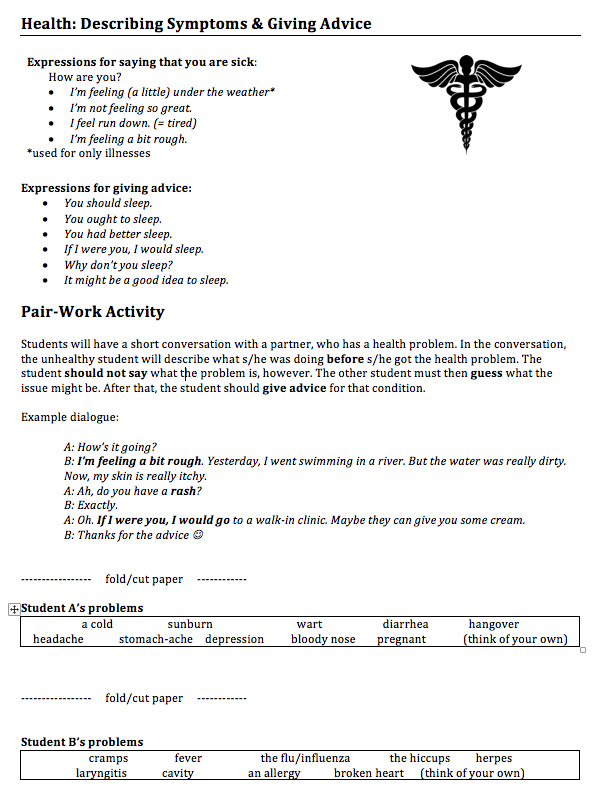Target Language: health conditions (vocabulary), expressions for giving advice
ESL Level: intermediate, upper-intermediate
Class Time: 40 minutes
Summary: Students describe how they got a health problem and then receive advice to treat it.
Worksheet Download: health-causes-advice-activity.docx
This speaking activity is a combination of two activities that can be useful for studying health problems: i) describing the cause (or symptoms) of an illness, and ii) giving medical advice.
Before doing this activity, you need to teach your students the names of common health problems (influenza, a rash) or injuries.
Speaking Activity Preview

Preparation (5 minutes)
1. Change the vocabulary in the two boxes on bottom of the sheet (Student A's problems/Student B's problems) so they contain vocabulary you have studied in class.
Note: one box says 'herpes' because that language was elicited from my class the day before; you'll want to remove this if your students won't be comfortable with the topic. Also I included 'broken heart/pregnancy' on the sheet (though of course they are not illnesses) because they will lead to interesting stories about their causes. Change vocabulary as needed.
2. Cut 'Student A problems' and 'Student B problems' part of sheet so you can distribute them separately. (Or have your students fold them in such a way that they can see the instructions without seeing their partner's answers.)
Health Problems Activity Execution
This is how I ran the activity.
- First, tell your students that you are not feeling good. Ask them for expressions that they can use when someone asks them 'How are you?' but they are not feeling good. Write them on the board. Pre-teach the expressions from the top of the worksheet as well.
- Next, tell your students that you have a health issue [e.g. a rash]. Elicit advice. Write expressions for giving advice on the board. Include the expressions from the worksheet.
- Put students in pairs.
- Distribute worksheet (preview above).
- Review expressions at top; tell class you'd like them to use the expressions in a conversation with their partner.
- Have a student read the instructions under 'Pair Work Activity'. This won't be enough for them to understand. Do the sample dialogue with a partner (on sheet).
- A: How's it going?
- B: I'm feeling a bit rough. Yesterday, I went swimming in a river. But the water was really dirty. Now, my skin is really itchy.
- A: Ah, do you have a rash?
- B: Exactly.
- A: Oh. If I were you, I would go to a walk-in clinic. Maybe they can give you some cream.
- B: Thanks for the advice :)
Explain that they are going to be given a list of health problems, and show them a 'StudentA Problems' slip. Explain that they are to choose a problem, and then try to create a story about how they got the condition. Their partner should then, by listening to the story, guess what the problem is. After doing so, they should give advice.
Role-play another condition (e.g. cavity) with the class (for example: "In the past week, I haven't been able to eat well. Whenever I eat cold things, my teeth hurt soo badly...")
- Once the students understand, distribute the health problem cards and let them begin.
--
That's it. My students enjoyed the activity once they understood the concept of the backstory. Instead of giving a backstory, your students can also explain their symptoms if that's something you have studied. It took about 10 minutes to stage and explain and 30 minutes of speaking time. Give it a try, and remember to modify the 'health problems' (and expressions if you want) so they suit your class!
Best of luck with your classes.
-- Matthew Barton / Creator of Englishcurrent.com

It’s a good exercise _ i like how it pushes students to actually explain symptoms which is a actually a good life skill ( for all of us!)
Fantastic activity. Thanks.
Well done on this activity, but I have to adapt it to a one off 45 min lesson, as I only see the SS once a week.